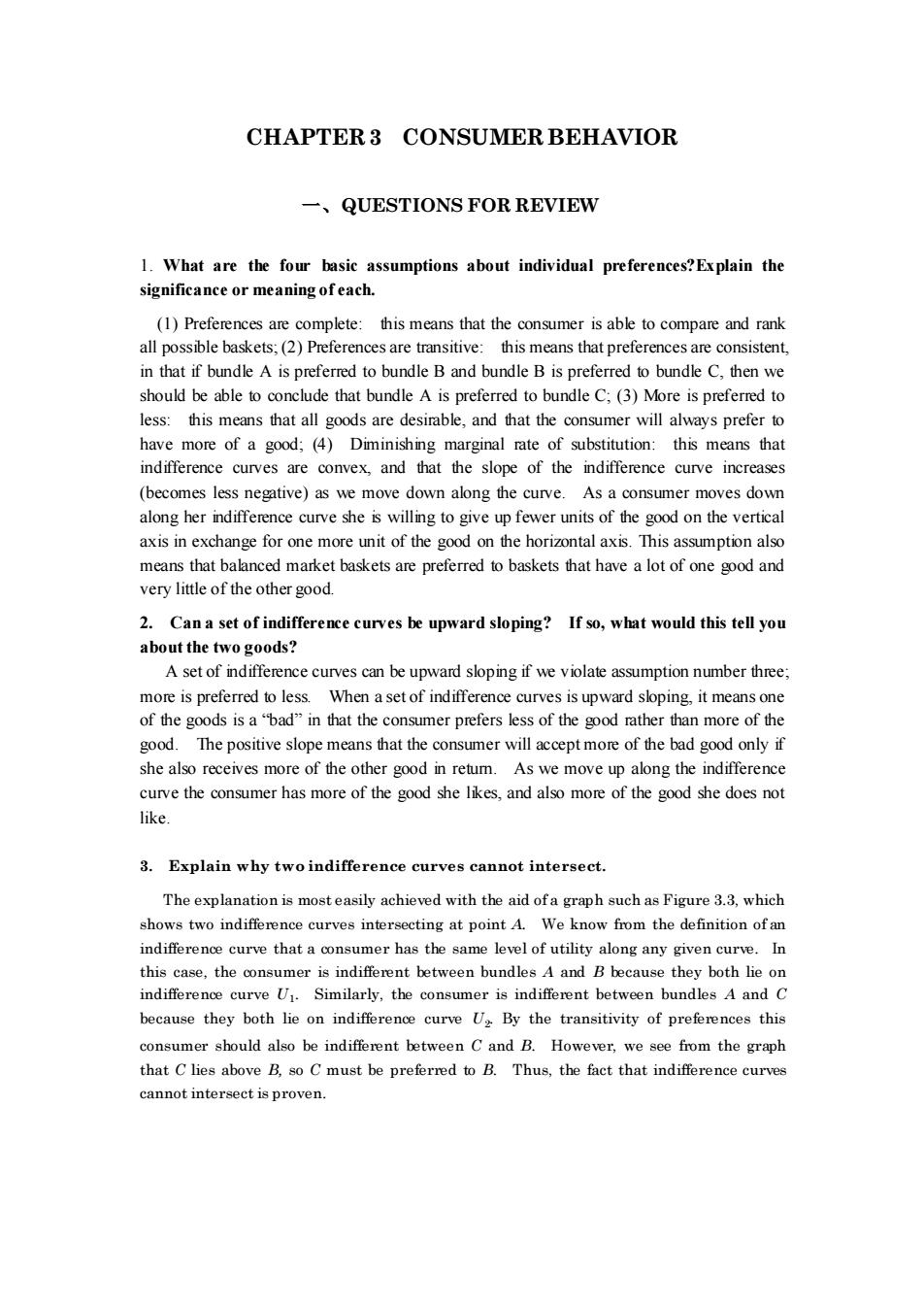正在加载图片...

CHAPTER3 CONSUMER BEHAVIOR 一、QUESTIONS FOR REVIEW 1.What are the four basic assumptions about individual preferences?Explain the significance or meaning ofeach. (1)Preferences are complete:this means that the consumer is able to compare and rank all possible baskets:(2)Preferences are transitive:this means that preferencesare consistent. in that is preferred to bu Band bunle Bis prefer red to bundle C.then should be able to conclude that bundle A is preferred to bundleC.(3)More is preferred to less:this means that all goods are desirable,and that the consumer will always prefer to have more of a good;(4)Diminishing marginal rate of substitution:this means that indifference curves are convex,and that the slope of the indifference curve increases (becomes less negative)as we move down along the curve.As a consumer moves down along her indifference curve she s willing to give up fewer units of the good on the vertica axis in exchange for one more unit of the good on the horizontal axis.This assumption also means that balanced market baskets are preferred to baskets that have a lot of one good and very little of the other good. 2.Cana set of indifference curves be upward sloping?If so,what would this tell you about the two goods? A set of indiffe ence curves can be upward slping if we violate assumption number three more is preferred to less.When a set of indifference curves is upward sloping.it means one of the goods is a"bad"in that the consumer prefers lss of the good rather than more of the good.The positive slope means that the consumer will accept more of the bad good only if she also receives more of the other good in retum.As we move up along the indifference curve the consumer has more of the good she likes.and also like. mo元 of the good she does not 3.Explain why twoindifference curves cannot intersect. The explanation is most easily achieved with the aid ofa graph such as Figure 3.3,which shows two indifference curves intersecting at point A.We know from the definition ofan curve thai t a con mer has level of utilit ng any given c this case.theoo t between bundle and 3 because th indifferene curve U.Similarly,the consumer is indifferent between bundles A and because they both lie on indifference curve U2 By the transitivity of preferences this consumer should also be indifferent between C and B.However,we see from the graph that Clies above B.soCmust be preferred to B.Thus,the fact that indifference eurve cannot intersect is provenCHAPTER 3 CONSUMER BEHAVIOR 一、QUESTIONS FOR REVIEW 1. What are the four basic assumptions about individual preferences?Explain the significance or meaning of each. (1) Preferences are complete: this means that the consumer is able to compare and rank all possible baskets; (2) Preferences are transitive: this means that preferences are consistent, in that if bundle A is preferred to bundle B and bundle B is preferred to bundle C, then we should be able to conclude that bundle A is preferred to bundle C; (3) More is preferred to less: this means that all goods are desirable, and that the consumer will always prefer to have more of a good; (4) Diminishing marginal rate of substitution: this means that indifference curves are convex, and that the slope of the indifference curve increases (becomes less negative) as we move down along the curve. As a consumer moves down along her indifference curve she is willing to give up fewer units of the good on the vertical axis in exchange for one more unit of the good on the horizontal axis. This assumption also means that balanced market baskets are preferred to baskets that have a lot of one good and very little of the other good. 2. Can a set of indifference curves be upward sloping? If so, what would this tell you about the two goods? A set of indifference curves can be upward sloping if we violate assumption number three; more is preferred to less. When a set of indifference curves is upward sloping, it means one of the goods is a “bad” in that the consumer prefers less of the good rather than more of the good. The positive slope means that the consumer will accept more of the bad good only if she also receives more of the other good in return. As we move up along the indifference curve the consumer has more of the good she likes, and also more of the good she does not like. 3. Explain why two indifference curves cannot intersect. The explanation is most easily achieved with the aid of a graph such as Figure 3.3, which shows two indifference curves intersecting at point A. We know from the definition of an indifference curve that a consumer has the same level of utility along any given curve. In this case, the consumer is indifferent between bundles A and B because they both lie on indifference curve U1 . Similarly, the consumer is indifferent between bundles A and C because they both lie on indifference curve U2 . By the transitivity of preferences this consumer should also be indifferent between C and B. However, we see from the graph that C lies above B, so C must be preferred to B. Thus, the fact that indifference curves cannot intersect is proven